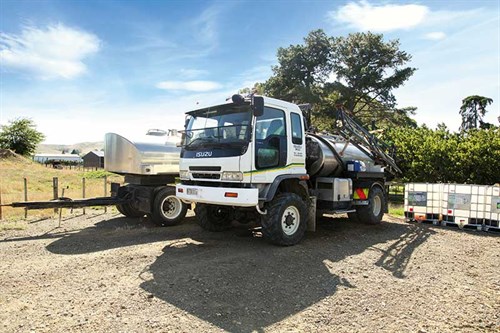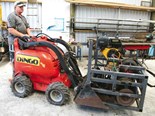Cultivation: Fogarty Chemical Applicators













|

|

|

|

|

|
Weed and pest control followed by an on-going spray programme is paramount when it comes to giving crops a good head start, thus maximising their yield.
Paddy Fogarty knows the seasonal routine involved with agricultural spraying in his area well. The Central Hawke’s Bay contractor has notched up 44 years in the business and, in that time, has gained a wealth of applicable knowledge.
Not only that, because he’s been in the game for so long, in some cases he’s onto a third generation of clients. "That’s loyalty for you isn’t it?" he says.
At present, squash crops are coming to an end and because of recent humid conditions; a final spray of fungicide is necessary to prevent mildew.
"We’ve had a bad year with white butterfly, so consequently we’ve done a lot of insecticide on fodder crops such as kales, rapes and fodder beet to keep on top of things."
The humid weather also means he’ll be watching for signs of facial eczema.
Next up, he and his team will be spraying any new grasses that have gone in or applying Roundup weedkiller to older crops. "Once crops are in we also spray for weeds and insects and as the crop matures, we continue to spray right through to the end."
In-between, they do a lot of spraying of thistles. "Best done in winter so we are not damaging pastures – and fair bit of liquid nitrogen application for dairy farmers," he says.
In early spring, the Fogarty crew does round-up work – preparing for the crops and spraying grasses out for winter crops. "These will then go into crops such as squash, potatoes, barley, peas, wheat or lucerne. When those are in the ground, if they have weed or insect or fungicide problems, we spray them again. Every season is different though and it’s all weather dependent; that rules our lives in this business."
Fogarty got into the business straight from school, working for his father on contract spraying and milling totara fence battens plus a bit of possuming and firewood during the winter months.
He then worked for a local spraying contractor before buying out that business when he was 23. "The range of work you did back then was mainly thistles in the hill country as well as gorse and blackberry. It’s changed a lot and we are now mainly involved with cropping."
Fogarty says chemicals have changed substantially and are now a lot safer and user-friendly.

Besides this, the monitoring of them is huge. Fogarty’s wife Erin, who handles the compliance side of the business, says, "There’s a lot more work on the hazard side now and compliance is a full-time job. Tracking chemicals is a big thing and we have to account for everything; as soon as it leaves the supplier we are totally responsible for it and any left over. We have to be able to tell you exactly where it is.
"This task is made easier because I use good software. I can print out audit trails of what that chemical has done and where that job is."
Fogarty smiles when he recalls the machinery he once worked with. "We began with old Land Rovers with 500-litre tanks and 4.5-metre booms. We also used crawler tractors for spraying."
"Now we get around in these big flash machines with 24-metre booms and 3000-litre tanks. These are all computerised and have GPS. It’s all good, until you have a breakdown and you have to head to town. In the old days we could fix it all ourselves."
Fogarty keeps his machinery up to date and says he has "a machine for everything we need to work on."
The latest additions are two brand new trucks, both under 10 tonnes – a Mercedes and an Isuzu – that have yet to have their spraying gear added to them.
He has a Multidrive 6200 with a Hardi 21-metre air boom for the squash. This machine forces or blows the product down into the crop and works really efficiently, he says.
"We have a JCB Fast Track 4 wheel steer with 20-metre boom. It was originally out at 24 metres but is easier to handle at 20. This is used mainly on squash and as a spare machine."
"We also have an old Unimog with new gear on it, which we use on fodder beet. We’ve had to extend the wheelbase out to two metres to straddle the fodder beet rows because they are fairly awkward to spray. This is used for three to four months of the year."
Two Isuzu 350 trucks with 16-metre booms are used for hill country and for fodder crops such as brassicas and kales.
Fogarty also owns three farms – two dairy, and one dry stock unit. His latest venture is into the Manuka honey business, which he’s establishing on a rough bush block he owns.
He made the move to diversify from spraying following a "good break years ago when the goat boom was on. We farmed 100 acres deer fenced, so we could buy in feral goats and sold just before the goat market collapsed."
He’s able to apply the knowledge he’s accrued over the years and is pleased with the results.
"We’ve got better at getting increased yields but we’ve got to spend the money to get them: there are no short cuts in cropping. If you’ve got the weather against you it can be money down the drain. We do use agronomists as they supply the chemicals and we let them have a bit of a say, but it’s good to know what we are doing. We can usually see things before they happen."
For the latest farming news, subscribe to Farm Trader magazine here.
Keep up to date in the industry by signing up to Farm Trader's free newsletter or liking us on Facebook

.jpg)












